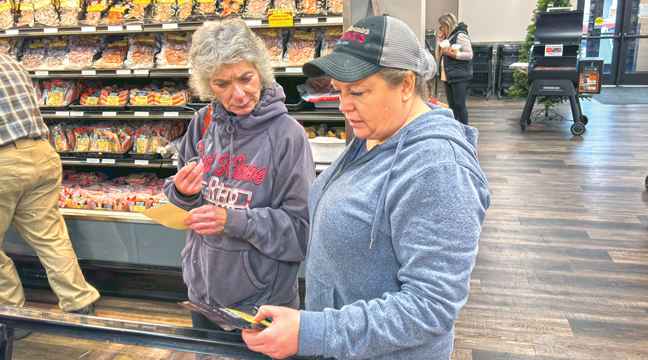Members of the Briggs Lake Chain Association (BLCA) have been working diligently over the years to maintain lake water quality and prevent shoreline destruction.
But as projects become more costly, trying to fund improvements is becoming more and more difficult.
At a workshop with the Sherburne County Commissioners last week, Dan Merchant and Kenzie Phelps of the BLCA presented a proposal to establish a lake improvement district (LID) to help fund projects on the Briggs Lake Chain.
Merchant, the BLCA president, gave a presentation on the history of the Briggs Lake Chain and what challenges the BLCA faces. He said the lakes and adjacent properties have a shared history.
“These areas share high water events, low water events, and all can be accessed from public landing, increasing their vulnerability the introduction to aquatic invasive species (AIS),” he said. “All have deteriorated water quality and are on the MPCA impaired waters list.”
Merchant said BLCA members and volunteers have been contributing financially with their time and expertise to many projects to improve water quality and protect the lakes.
But there are three chronic problems that are not easily treated: Water stabilization, which includes high water events, low water nuisances, flooding; water quality and AIS.
“These three issues threaten the legacy we are trying to leave for future generations,” he said.
Rush Lake Dam
Merchant talked about the Rush Lake dam, built in 1932 by the DNR, and a portion of Briggs Creek that was filled in.
“My theory is they had to fill part of Briggs Creek to get the water level to rise in the upper lakes,” he said. “Then they put the dam in to keep it there. It worked. You can navigate all three of the upper lakes.”
But Merchant said failure of that dam would drain the lakes. And maintaining the dam has been an issue. The adjustable panel that controlled water height was stolen in 2008, and the BLCA had to fix the problem.
“When we discovered the dam had been vandalized, we contacted the DNR to have them repair it because they own it,” said Phelps. “Their response was, we have one person statewide that does dam maintenance and he may or may not get here. He didn’t get here, which led us to doing it ourselves.”
That was just one example of how the BLCA had to step up to save the lakes, said Merchant. And the BLCA also plans to put more boulders on the fill areas around the dam this spring.
“It’s an expense we’re going to have to bear as an association, scraping up donations,” he said. “Fundraising is a challenge.”
Funding
In 2013, the BLCA spent $13,435 to control curlyleaf pondweed on the lakes, and over $40,000 in the four years prior to that. Money came from donations by BLCA members, charitable groups and DNR grants.
But Phelps said it is difficult to rely on grants and donations because they are not guaranteed and they can fluctuate each year.
The proposed LID would provide predictable and sustainable funding, protect economic investment by increasing property values, and would provide for shared financial responsibility and benefits. But it would require property owner participation.
Phelps said currently, about 50% of property owners on the lakes are “free riders.”
“They don’t contribute to the weed management. They don’t pay dues but they benefit from everything else the lake association has done,” he said.
Proposed LID
Under a LID, all property owners on the lake and river within the specified district would contribute financially and reap the benefits. The proposed LID map encompasses 639 properties with a tax base of just over $106 million.
Phelps said an LID does not have taxing authority. The county board specifies the funding arrangement when it established the LID. The board could decide to assess costs to benefitting properties; impose service charges; issue general obligation bonds or levy a tax on properties within the LID.
The amount of the budget is set at an annual meeting of the LID members, who vote on whether or not to fund specific projects for the upcoming year.
Projects could include constructing or acquiring a dam, building and maintaining water and sewer systems, conduct research or regulate water surface use.
Phelps said there are about 50 LIDs in the state and more being proposed. Most are done by petition of the affected property owners within the LID. But a LID can also be established by county board resolution.
Regardlesss of the initiating process, a public hearing must be held and notices sent to each landowner within the LID.
Merchant said they have not started the petition process yet. Phelps said he preferred that the board start the process of forming an LID by resolution.
No official vote was taken, since it was a workshop. But the commissioners’ consensus was, they preferred the landowners start the process.
“I think you should do it by petition,” said Commissioner Rachel Leonard. “I don’t think the county should initiate it.”
Commissioner Felix Schmiesing agreed.
“I think what you’re talking about has a great deal of merit and a lot of support. I appreciate that it is grass roots - people deciding what they’re going to do with their money and how they’re going to do it,” he said. “Being that form of government, I would like to see a groundswell flow up to the board rather than this board mandating it down.
“Do the petition process and demonstrate to us that those folks out there are really interested in it.”
“I’ll go with the petition, too,” said Commissioner John Riebel.
Now it is up to the BLCA to decide when to start the petition process.










